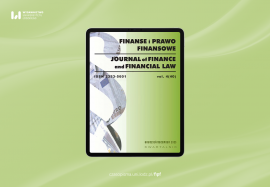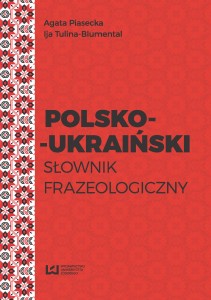Finanse i Prawo Finansowe | Tom 4 Nr 40
Opublikowano: 15 stycznia 2024

Kwartalnik JoFFL jest recenzowanym czasopismem naukowym, w którym zamieszczane są oryginalne artykuły naukowe, często łączące teorię z praktyką, odnoszące się do finansów oraz powiązanych z nimi dziedzin. Łamy czasopisma są otwarte również dla przedstawicieli nauk prawnych, którzy podejmują tematykę regulacji finansowych.
Celem czasopisma jest promowanie i publikowanie wyników badań z zakresu finansów, inspirowanie autorów, a także czytelników, do lepszego zrozumienia, zdefiniowania i wyjaśniania ważnych, w szczególności bieżących zjawisk oraz mechanizmów finansowych. Zadaniem czasopisma jest: udostępnienie forum do upowszechniania rezultatów badań oraz wymiany opinii, prezentacja indywidualnych i zespołowych dokonań naukowych.
Redakcja prowadzi stały nabór artykułów do czasopisma Finanse i Prawo Finansowe.
The JoFFL quarterly is a peer-reviewed scientific journal that publishes original research articles, often combining theory with practice, relating to finance and related fields. The journal is also open to representatives of legal sciences who take up the subject of financial regulations.
The aim of the journal is to promote and publish the results of research in the field of finance, inspiring authors, as well as readers, to better understand, define and explain important, in particular current financial phenomena and mechanisms. The task of the journal is to provide a forum for dissemination research results and exchange of opinions, presentation of individual and team scientific achievements.
The editors are constantly recruiting articles for the journal JoFFL.
W numerze / Features:
Dariusz Kowalski, Adam Zając
The purpose of the article/hypothesis: The purpose of the article is to determine whether, taking into account the current legal framework determining the state role in the economy, it is advisable to support large enterprises in relation to preventing the effects of the COVID-19 pandemic. The analysis will be conducted based on one of the types of guarantees – PLG FGP guarantee line.
Methodology: In order to achieve the assumed goals, the analysis was based on non-reactive research, consisting in the assessment of available information. It included studies of normative acts, official statistical data and industry reports and analyses. Two basic research methods were used, namely legal dogmatic and comparative analyses.
Results of the research: Based on the conducted research, it can be concluded that taking into account the characteristics of economic difficulties resulting from the COVID-19 pandemic (i.e. a decrease in demand for goods and services, reduced mobility of the population, limited supply caused by disruption of supply chains and absence of employees at the workplace), it is justified to support sector of large enterprises, because these problems concern both the SME sector and large enterprises to a similar extent. However, it is reasonable to direct the aid because financing was also used by enterprises that were not affected by the crisis.
Rola banków gwarancyjnych w Niemczech w tworzeniu harmonijnego rozwoju przedsiębiorstw z sektora MŚP
Anna Dąbkowska
W artykule podjęto próbę zbadania roli banków gwarancyjnych, których głównym celem działalności jest wspieranie rozwoju konkurencyjności przedsiębiorstw MŚP poprzez umożliwienie im dostępu do kredytowania poprzez udzielone gwarancje i poręczenia kredytowe, w tworzeniu harmonijnego rozwoju przedsiębiorstw tego sektora. Na początku scharakteryzowano banki gwarancyjne oraz ich wartość dodaną dla gospodarki. W części empirycznej, na podstawie danych zaczerpniętych z Verband Deutscher Bürgschaftsbanken e.V. przedstawiono ich udział we wspieraniu rozwoju przedsiębiorstw z sektora MŚP w okresie przed pandemią COVID-19, jak i w jej trakcie. Z przeprowadzonej analizy wynika, że banki gwarancyjne zwiększają efektywność operacyjną i przyczyniają się do zmniejszenia asymetrii informacji, specjalizując się w ocenie kredytowej przedsiębiorstw (bardziej jakościowej, niż ilościowej), a przy tym zmniejszają lukę finansową. Ich działalność oddziałuje pozytywnie również na instytucje kredytowe, bowiem biorą one na siebie dużą część ryzyka. Dzięki ich działalności w Niemczech panuje korzystny klimat do zakładania nowych przedsiębiorstw, których często jedynym kapitałem jest „specjalistyczne know-how”, jak i innowacyjne przedsięwzięcie.
Postrzeganie inflacji oraz metody ochrony studentów przed jej negatywnymi skutkami
Bartosz Buta
Cel artykułu/hipoteza: Celem artykułu jest przedstawienie i analiza postrzegania inflacji i wiedzy na jej temat, a także metod ochrony studentów przed jej negatywnymi skutkami.
Metodyka: Praca zawiera przegląd literatury w temacie współczesnej inflacji oraz analizę badania naukowego o tytule „Postrzeganie inflacji oraz metody ochrony studentów przed jej negatywnymi skutkami”. Badanie zostało przeprowadzone metodą CAWI na próbie 329 respondentów. Próba była losowa.
Wyniki/Rezultaty badania: Analiza przeprowadzonego badania wykazała, że studenci, mimo iż orientują się w obecnej sytuacji inflacyjnej, to słabo rozumieją samo zjawisko. Aby zabezpieczyć się przed negatywnymi skutkami inflacji, stosują różne powszechnie znane metody, takie jak zwracanie uwagi na wydatki, oszczędzanie energii, a także wszelkiego rodzaju inwestycje. Jednakże nie wszyscy starają się uchronić swoje oszczędności przed negatywnymi skutkami inflacji. Działania części ankietowanych uzależnione są od wyższych wartości wskaźnika CPI. Organy publiczne odpowiedzialne za przeciwdziałanie wzrostu cen oraz łagodzenie negatywnych skutków tego zjawiska nie cieszą się zaufaniem studentów. Lecz mimo świadomości na temat destrukcyjnego wpływu wysokiej inflacji na swoje oszczędności oraz na cały obrót gospodarczy, część studentów jest świadoma pozytywnych skutków, jakie niesie ze sobą kontrolowana inflacja.
Household Saving in Crisis – Literature Review
Anna Korzeniowska
The purpose of this article is to compare the focus of researchers and the saving behavior of households in different types of crises within the scope of the financial crisis of 2008 and the pandemic crisis.
The research focused on the literature review of publications in the WoS bibliographic database concentrated on saving and personal finance with the addition of a crisis or pandemic. 276 publications in the WoS category of Economics were identified. Full and fractional clustering with VOS Viewer was applied.
It has been found that there are differences in the behavior of households and in the focus of researchers concerning analyzed terms between the pandemic and other crises. In the case of the financial crisis of 2008, a broader approach prevailed, considering the situation of the financial market and its liquidity, but also inequalities and imbalances at the individual, national and international levels. When it comes to the pandemic, the term savings had the most associations with problems related to the situation of an individual household. Attention was paid to financial security, income, wealth, and demand generated by the household.
Krzysztof Waliszewski, Przemysław Barankiewicz
Cel artykułu/hipoteza: W warunkach niewydolności obowiązkowych filarów systemu emerytalnego zasadne jest zachęcanie przyszłych emerytów do zapobiegliwości i oszczędzaniu w dobrowolnych formach gromadzenia kapitału emerytalnego. Dotąd kwestia ta nie podlegała europejskiej harmonizacji. Jednak w związku z przyjęciem rozporządzenie o Ogólnoeuropejskim Indywidualnych Produkcie Emerytalnym (OIPE) sytuacja ta zmieniła się. Celem artykułu jest prezentacja opinii posiadaczy Indywidulanych Kont Emerytalnych (IKE) w Polsce na podstawie badania własnego w kontekście implementacji OIPE w Polsce. Hipoteza artykułu jest następująca: zadowolenie posiadaczy IKE z osiągniętych stóp zwrotu jest umiarkowane, co daje możliwość poprawy tej oceny w przypadku implementowanego OIPE. Ponadto w artykule przedstawiono zależności między wieloma parametrami charakteryzującymi IKE a cechami socjodemograficznymi i zadowoleniem użytkowników z IKE.
Metodyka: Badania empiryczne przeprowadzone zostały na ogólnopolskiej grupie blisko 550 posiadaczy IKE za pomocą ankiety internetowej CAWI we wrześniu 2022 r. Ponadto w artykule wykorzystano studia literatury, aktów prawnych i analizę statystyk rynkowych w zakresie dobrowolnych form gromadzenia kapitału emerytalnego w Polsce w ramach III filaru.
Wyniki/Rezultaty badania: Przeprowadzone badanie wskazuje, że występuje umiarkowane zadowolenie z osiąganych przez IKE wyników finansowych (6,62/10 pkt), co przekłada się na przewagę krytyków nad promotorami i ujemny wskaźnik NPS (ang. Net Promoter Score) na poziomie ponad 26. Ankietowani w ramach OIPE chcieliby inwestować w aktywa zagraniczne i globalne tj. ETFy, akcje i obligacje globalne. Może to oznaczać w przyszłości większe stopy zwrotu z OPIE w porównaniu z IKE, co może przełożyć się na poprawę zadowolenia klientów i lepszy wskaźnik NPS. Należy dodać, że wyniki badania mają znaczenie aplikacyjne, ponieważ zostały wykorzystane przy wprowadzaniu na polski rynek pierwszego OIPE pod nazwą Europejska Emerytura przez słowacki dom maklerski Finax, który uzyskał licencję KNF na tego typu działalność.
Civic budget and its role in the process of urban reconstruction – a case study of the city of Lodz
Magdalena Ślebocka, Artur Kilanowski
The purpose of the article/hypothesis: The aim of the article is to assess the role and importance of the civic budget in a broader processes of reconstruction of the degraded urban fabric in the period 2016–2023. The article poses a research hypothesis that the civic budget, as an advanced form of social participation not limited to information or public consultation, is a tool supporting the implementation of revitalization processes undertaken in the city. The research questions were helpful in verifying the proposed hypothesis: 1) Does the civic budget support revitalization processes? 2) What types of projects submitted as part of the civic budget are included in revitalization measures? 3) How is the tool that the civic budget is in revitalization perceived by stakeholders and initiators of these processes?
Methodology: The research involved a literature review and an analysis of numerical data and information on revitalization projects that can be found in the civic budget of Lodz. The study also used an original survey questionnaire conducted among the residents.
Results of the research: It was found that the civic budget in Lodz contributed to the implementation of a number of revitalization projects. The high civic awareness of the residents and their knowledge of the needs of their surroundings make it possible to implement these projects in areas where the condition of the urban fabric is critical. Thanks to the civic budget, the city’s residents have had and continue to have an opportunity to make changes in their immediate environment. They can realize the most important investments from the point of view of local needs.
Dagmara Hajdys
Karol Ślasko, Joanna Stawska
The aim of the article is to identify the changes of selected economic variables in Japan, Poland, the USA and the euro area and to evaluate the impact of these variables on these economies in 2000–2022.
The hypothesis posed in the article: The economies of Japan, Poland, the USA and the euro zone have overcome the economic shocks that occurred in the first two decades of the 21st century.
Methodology: The study included a review of the literature on the subject, the presentation and analysis of statistical data, including its graphical presentation. Six economic indicators were selected for analysis, such as: the unemployment rate, inflation, General Government debt, long-term interest rates, GDP per capita, and GDP growth in Japan, Poland, the United States and the euro area in 2000–2022.
Results of the research: Over the past 20 years, economies have been hit by unprecedented crises such as the Global Financial Crisis (GFC) and Covid-19, and yet we note that the surveyed countries and the euro zone showed positive economic growth for most of the period and successfully fought unemployment. Japan tried to get out of periods of deflation, but out of the examined 23 years, deflation was recorded in Japan for 15 years. In the years 2000–2022, the highest economic growth was most often recorded in Poland and the lowest in Japan, but the highest inflation was also most often recorded in Poland. In all the surveyed countries and the euro zone, a tendency to increase the GG of debt was clearly noticed.
Impact of JPY LIBOR Rate Changes on Regulations and Development of Alternative Benchmarks in Japan
Dominik Kubacki
The purpose of the article/hypothesis: The considerations presented in this article aim to focus on the final choice of benchmarks in Japan, which operated the LIBOR rate expressed in Japanese yen. In turn, the main purpose of the article is to try to answer whether the newly selected alternative benchmarks in the Tokyo market meet the characteristics of an ideal rate.
Methodology: The paper reviews the literature, studies of regulators and index administrators, presenting the stages of reform, the selection of alternative reference rates and making a comparative analysis with the previously functioning LIBOR rate. Due to the subject of the analysis, basic statistical methods were used.
Results of the research: The course of benchmark reform in the Japanese market indicates that the reform has been successfully thought out and implemented, and the rates proposed as alternatives are well able to replace the JPY LIBOR rate. However, it should be noted that in this market it was decided that there are three alternatives to choose from covering both interbank rates and risk-free rates. These rates are referred to as: TONA, TIBOR and TORF. Under these circumstances, market participants must consider the optimal choice of comparative options depending on their financial products, the nature of the transactions they are dealing with and their own individual business needs. However, judging whether they are better than the LIBOR rate, the answer is positive because they are based on acts.
Impact of Inflation, Markups and Wages on Changes in the Profitability of Enterprieses in Poland
Aneta Kosztowniak
The purpose of the study is to determine the impact of inflation, markups and wages on changes in the profitability of enterprises in Poland from 2008 to 2023, considering the effects in the short, medium and long term.
Methodology refers to the impact of CPI, markups and wages on changes in gross turnover profitability rates (GTPR) that were assessed using the VECM model, the impulse response function, and the variance decomposition.
Results of the research study show that the pillar of changes in the profitability of enterprises in Poland is its earlier changes with the increasing importance in the short term of markups, wages, and inflation (up to 10%) and gradually decreasing in the medium (up to 9%) and long term (7%). The importance of markups in the degree of explanation of changes in profitability is about 3–4 times stronger than that of wages. An increase in markups is an effective tool for stabilizing corporate profitability under inflation already in the short term, and can also be a tool to support an increase in such profitability in the medium and long term, if market conditions, including consumer demand, allow for it. The study fills a gap in the literature on the importance of markups and wages in shaping enterprises profitability in an inflationary condition, especially the use of markups as a tool that already produces expected effects in the short term.
Inne / Other:
Zuzanna Pakuła, Patryk Krykwiński, Daria Michalak
Komentarze
Ten post dostępny jest także w języku: angielski





